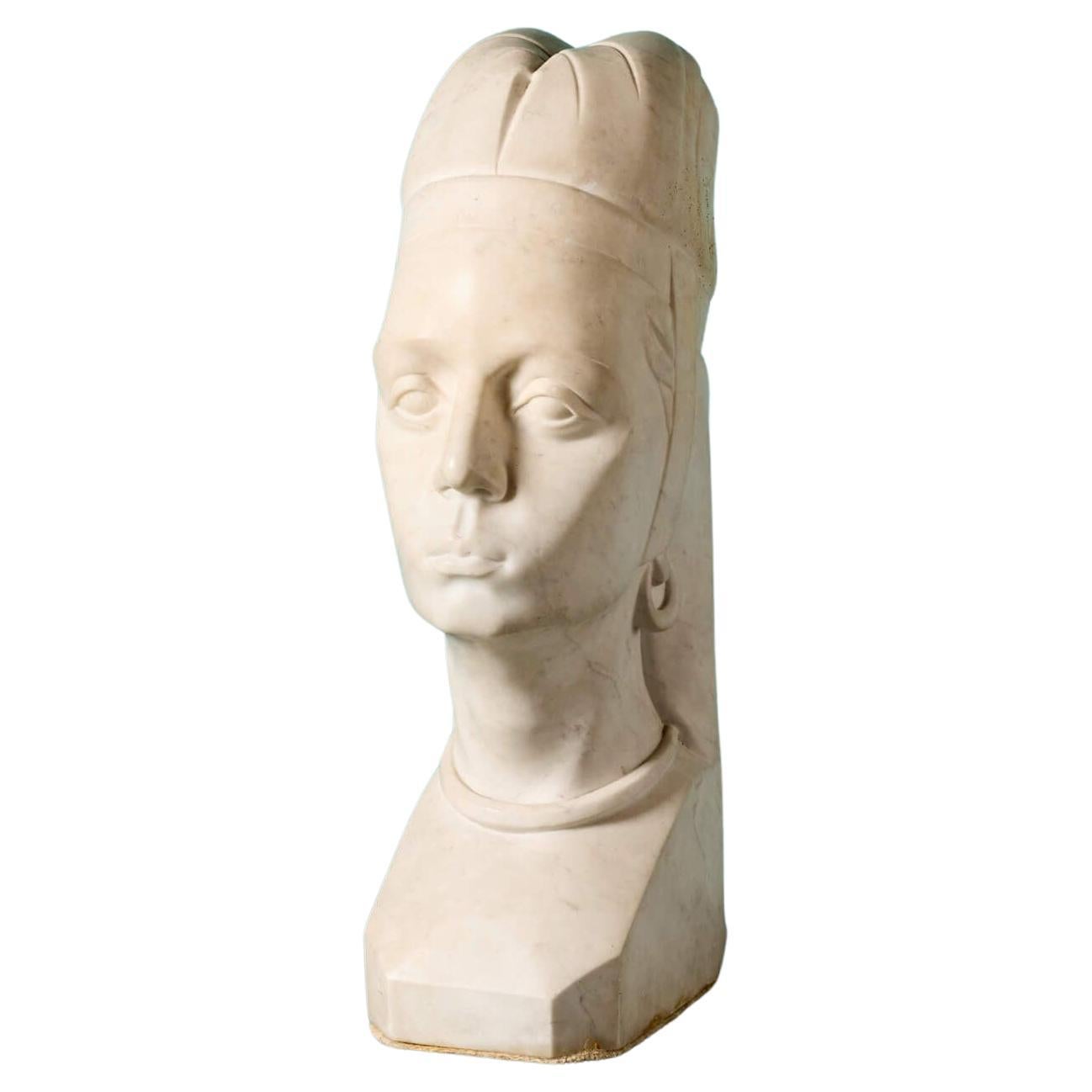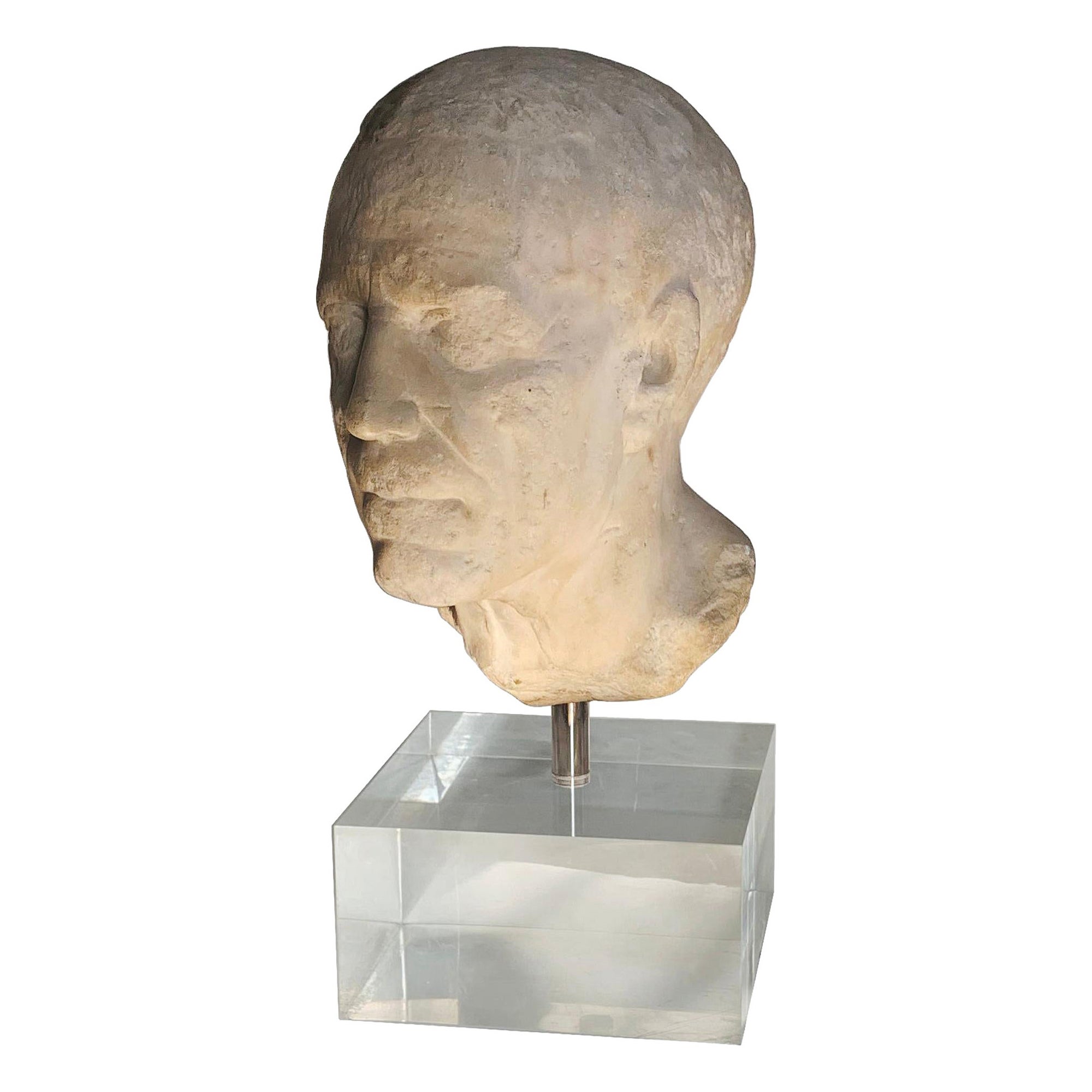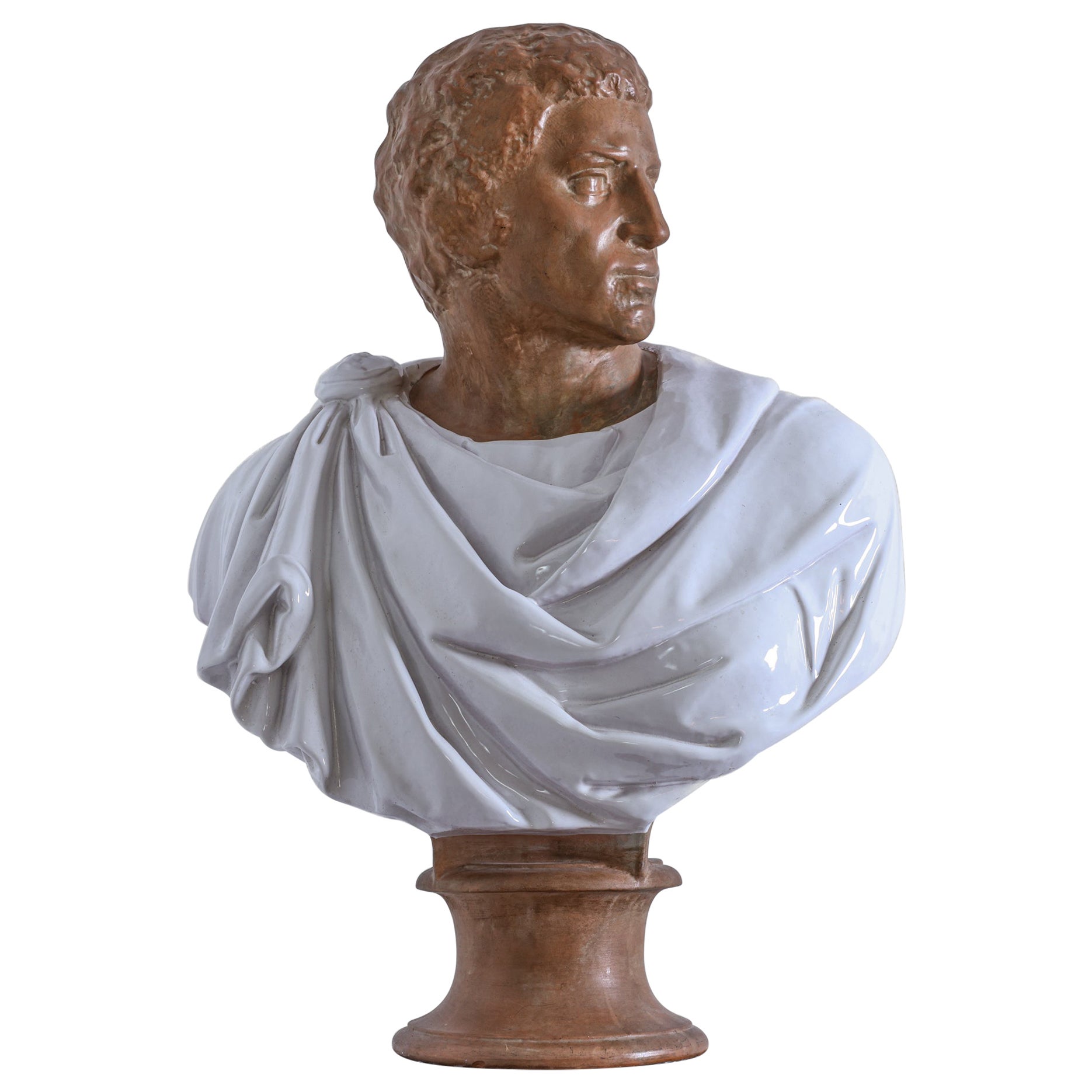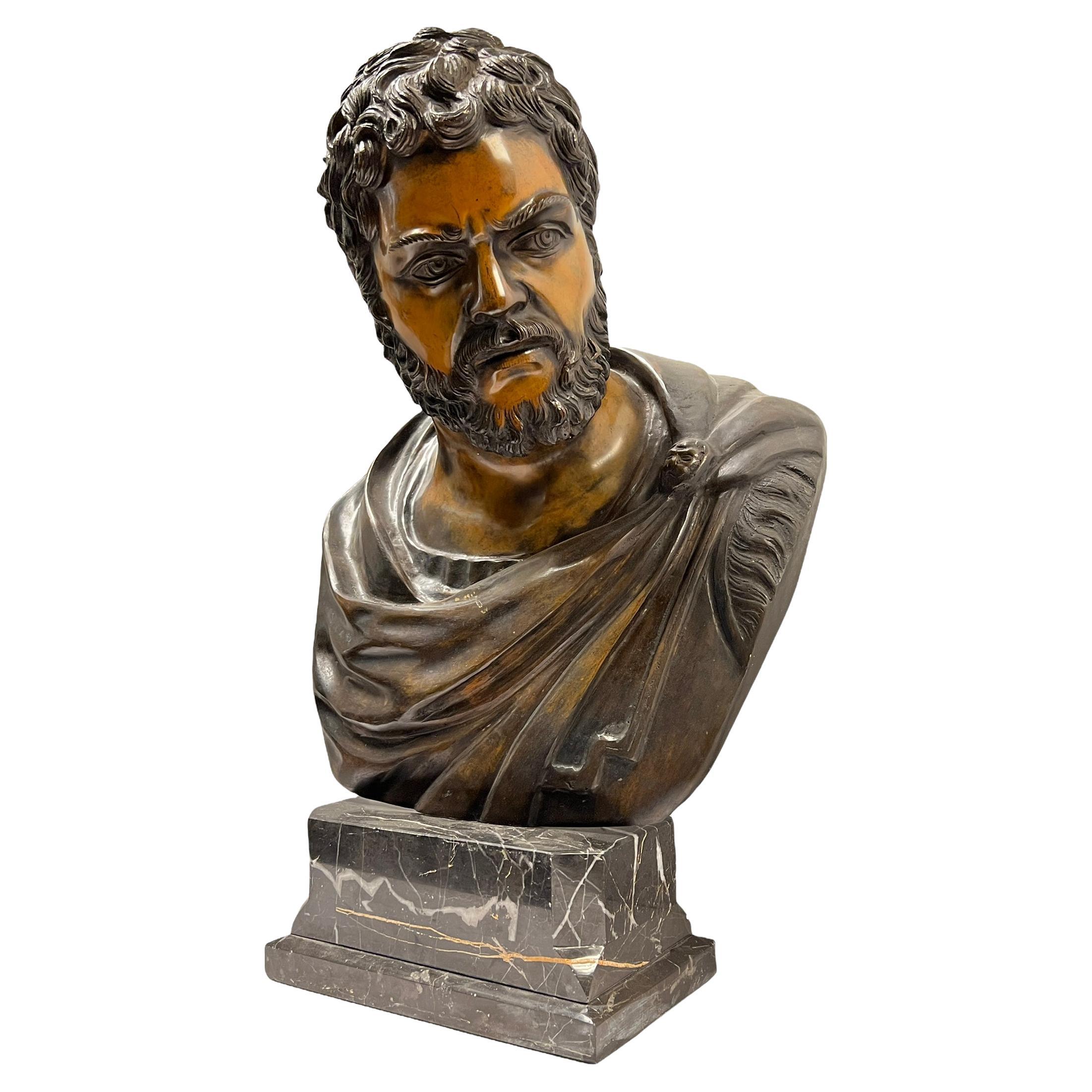Items Similar to Roman Portrait Bust of a Noble Woman
Video Loading
Want more images or videos?
Request additional images or videos from the seller
1 of 7
Roman Portrait Bust of a Noble Woman
About the Item
Roman miniature bust of a noble woman, carved marble, Severan Dynasty, c. 225 A.D.
Rare and particularly elegant ‘wig portrait’ of a noble woman, belonging to the early 3rd Century - a style distinctive of Severan Dynasty female portrait busts, in which part of the head has been chiselled away to allow for the addition of a separate hairpiece, in many cases from a darker material, in order to create an almost painterly effect, in the interplay of different coloured stones. The degree of naturalism and emotional depth achieved in a piece of such a small scale implies a sculptor of great talent. The subtle parting of the lips, in combination with her upturned, vacant gaze and tired eyes, conveys a pensive mood, and even a quiet melancholy.
A woman strolls the town in thick wigs bought with gold,
Then buys new hair to complement the old.
And having bought, she doesn’t blush! Right there she buys,
Before Alcides’ and the Muses’ eyes.
(Ovid, Ars Amatoria, III, 161-168)
The fashion of wig-wearing in this period, as well as its emulation in the wig portrait bust, is widely attributed to Julia Domna, the glamorous wife of Septimus Severus, who introduced the custom to Imperial society from her native Syria. Many of the ‘orphan’ hairpieces that have been discovered from the early 3rd century - that is, the carved wigs that would have accompanied since-lost portrait busts - feature the distinctive middle-parted finger waves that characterise Julia Domna’s popular image.
Measures: Height: 8.3 cm (3.25 inches) / 15.2 cm (6 inches) including base.
Provenance:
With James Nichols Art Studio, Kalamazoo, MI, USA.
Subsequently in the collection of Dr George ‘Yorgo’ Demetrakopoulos (1942-2021), likely acquired from the previous.
Subsequently US art market, June 2022.
- Dimensions:Height: 3.25 in (8.26 cm)Diameter: 1.9 in (4.83 cm)
- Style:Classical Roman (Of the Period)
- Materials and Techniques:
- Place of Origin:
- Period:
- Date of Manufacture:225 AD
- Condition:Wear consistent with age and use.
- Seller Location:London, GB
- Reference Number:
About the Seller
5.0
Recognized Seller
These prestigious sellers are industry leaders and represent the highest echelon for item quality and design.
Established in 2008
1stDibs seller since 2014
100 sales on 1stDibs
Typical response time: 7 hours
Associations
LAPADA - The Association of Arts & Antiques DealersInternational Confederation of Art and Antique Dealers' AssociationsThe British Antique Dealers' Association
- ShippingRetrieving quote...Ships From: London, United Kingdom
- Return PolicyA return for this item may be initiated within 14 days of delivery.
More From This SellerView All
- Roman Marble Head of SophoclesLocated in London, GBRoman Marble Head of Sophocles Circa 1st-2nd Century Marble This fine Roman marble head preserves the proper left side of the face of a middle-aged man, with broad nose, soft lips, and bearded chin. The short beard and sideburns have been finely carved with a flat chisel, to render the soft, wavy strands of hair. The cheekbone, undereye, and nasolabial folds have been delicately modelled in the marble by a skilled hand. In a letter from 1975, the former director of Ny Carlsberg Glyptotek, Copenhagen, suggested that the head could depict the Ancient Greek tragedian Sophocles. Few figures in the Classical world stand aside Sophocles (c. 496-406 BC), inarguably the best known of the Athenian tragedians, in terms of the impact his works have had on the history of art and literature. The psychological depth he achieves in the seven of the 123 of his plays that have survived to the present day - most notably the three Theban plays: Antigone, Oedipus the King, and Oedipus at Colonus - not only inspired the Athenians, among whom Sophocles was honoured as a hero long after his death, but in our own time, have provoked landmark works on phychoanalysis and literary criticism, by thinkers like René Girard and, most famously, Sigmund Freud. In its masterful treatment of the marble this fragment sensitively captures the features of one of the most important playwrights of all time. Height on stand: 7.9 inches (20 cm). Provenance: Collection of Danish sculptor Jens Adolf Jerichau...Category
Antique 15th Century and Earlier Classical Roman Busts
MaterialsMarble
- Roman Marble Statuette of JupiterLocated in London, GBRoman Marble Fragment of jupiter Circa 2nd-3rd Century A.D. Measure: Height: 19.7 cm This beautiful Roman fragmentary statuette depicts Jupiter, the king of the gods, here recognisable from his two chief attributes, the eagle with outstretched wings - according the Pseudo-Hyginus, singled out by Jupiter because ''it alone, men say, strives to fly straight into the rays of the rising sun'' - and the base of the scepter, which remains at the side of the left foot, an aspect likely borrowed from the statue of Zeus at Olympia, once one of the Seven Wonders of the World. Though much of the original piece has been lost, the subtle anatomical detail in the feet mark this out as a piece of exceptional quality, and the work of an artist of particular talent and patience - as Johann Winckelmann once said of the famous Belvedere Torso, ''if you contemplate this with a quiet eye [...] the god will at once become visible in this stone.'' This fragment once caught the eye of Henry Howard, 4th Earl of Carlisle (1694-1758), a Knight of the Garter and among the most prolific collectors of his day. The piece, acquired during his travels to Rome, was proudly displayed on an alcove of the Western Staircase of Castle Howard...Category
Antique 15th Century and Earlier Italian Classical Roman Figurative Scul...
MaterialsMarble
- Roman Marble FootLocated in London, GBRoman marble Fragment of a Right Foot with Sandal Circa 1st - 2nd Century A.D. An evocative Roman marble fragment, preserving the front portion of an over-lifesized sandalled foot. The toes, nails, and bridge of the foot have been sensitively carved. The outer sole of the sandal remains, with delicate, pointed straps joining between the first two toes in a diamond shape. This fragment once belonged to Danish sculptor Jens Adolf Jerichau...Category
Antique 15th Century and Earlier Italian Classical Roman Figurative Scul...
MaterialsMarble
- Roman Marble Head of a SatyrLocated in London, GBHead of a Satyr Roman, circa 2nd - 3rd century AD Carved and highly polished marble An extremely fine marble head of a satyr, depicted with ivy wreath, curly hair and pointed goat’...Category
Antique 15th Century and Earlier Busts
MaterialsMarble
- Hellenistic Grotesque Theatre Mask of MaccusLocated in London, GBGrotesque theatrical mask of Maccus Late Hellenistic or Early Imperial period, circa 1st century B.C. – 1st century A.D., likely from Southern Italy. Terracotta with remains of pin...Category
Antique 15th Century and Earlier Italian Classical Roman Figurative Scul...
MaterialsTerracotta
- Ancient Roman Turquoise Glass CupLocated in London, GBTurquoise glass cup Roman Empire, circa 3rd-4th century A.D. With old label reading ‘’965’’. “Pliny relates that the art of glass-making [.] was actua...Category
Antique 15th Century and Earlier Italian Classical Roman Glass
MaterialsGlass
You May Also Like
- Antique Art Deco Carrara Marble Bust of Noble WomanLocated in Wormelow, HerefordshireAn antique Art Deco Carrara marble portrait of a noble woman in a head dress, signed ‘schy’. Thought to be a lady in waiting, this handcarved detailed sculpture has a modernist, mid-...Category
20th Century English Figurative Sculptures
MaterialsMarble, Carrara Marble
- Ancient Roman Portrait Bust of a Man, 1st Century BCLocated in Brooklyn, NYA portrait of Roman aristocrat executed in the Veristic style. From the Latin "verus" meaning truth, the practice represented everyday subjects with great realism often including signs of age with exacting detail. Wrinkles, furrowed brows, and moles are presented as signs of wisdom and power and suggest the philosophical and moral character of the sitter. With the ascent of Emperor Augustus, eternal youth again took center stage, and verism fell into disfavor. The style enjoyed a resurgence after Emperor Vespasian came to power in 69 AD, Italy, 1st century BC. Provenance - the collection of Spanish fashion designer Elio Berhanyer...Category
Antique 15th Century and Earlier Italian Classical Roman Busts
MaterialsMarble
- Terracotta Bust of Roman EmperorLocated in Palm Desert, CAThis terra-cotta sculpture no doubt depicts the bust of Roman Emperor or Senator in classical dress gazing over his left shoulder. This is a magnificently robust life size bust...Category
Vintage 1960s Italian Classical Roman Busts
MaterialsTerracotta
- Bronze Bust of Roman EmperorLocated in New York, NYlarge and impressive mid century Italian Bronze Bust of Roman Emperor on a marble base.Category
Mid-20th Century Italian Classical Roman Busts
MaterialsMarble, Bronze
- Terracotta Portrait Bust of Caracalla Roman EmperorLocated in Wormelow, HerefordshireA terracotta portrait bust of Caracalla, Roman Emperor from 198 to 217 AD. The Emperor is depicted in expressive detail and wears a swathed toga which is glazed in white for a striking colour contrast. Similar portrait busts, showing Caracalla with cropped hair, stubble beard and a menacing glare, are found on display in museums across the globe including The Metropolitan Museum of Art, New York and The St. Louis Art...Category
Mid-20th Century Italian Neoclassical Busts
MaterialsTerracotta
- Ancient Roman BustLocated in Tyrone, Northern IrelandAn ancient Roman marble bust of a male, dating to the 1st-2nd century AD. Larger than life-size and depicting a male wearing a laurel wreath and milit...Category
Antique 15th Century and Earlier Italian Classical Roman Busts
MaterialsMarble
Recently Viewed
View AllMore Ways To Browse
3rd Century
Roman Period
Gold Noble
Coloured Stones
Classical Roman Style
Hand Carved Roman
Period Miniatures
Roman Heads Furniture
Antique Miniature Portraits
Antique Miniature Portrait
Miniature Portrait Antique
Roman Ad
Italian Ad
Roman Style Marble
Small Bust Head
Decorative Antique Style Scale
Sculpture Head Roman
Roman Head Sculpture





